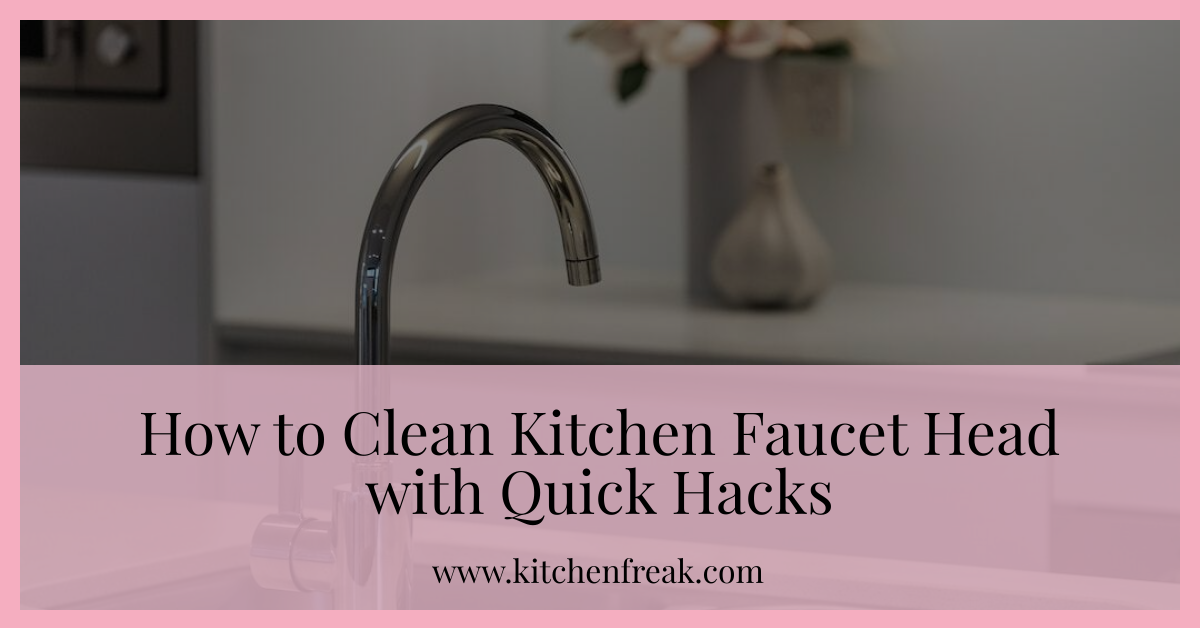Imagine you have a huge pile of dishes and you open the sink tap and all you get is a few splashes of water. Such a frustrating moment, right?

Table of Contents
How to Clean a Kitchen Faucet Head
Your kitchen faucet head may become blocked with calcium deposits and sludge over time, slowing down the flow of water. This means it’s now time to clean the faucet aerator. According to Jennifer Parnell, the co-founder of Humble Suds, as our main supply of water, faucets need to be cleaned every few months to avoid an accumulation of debris, dirt, and hard water deposits. In this article, you will learn how to clean kitchen faucet head through some easy and quick ways. So, keep reading:
How to remove the aerator from faucet
Your tap will have an aerator attached at the end. By firmly holding it and twisting it in a clockwise manner, you may loosen the aerator. Use a pair of tongue-and-groove pliers to carefully hold the aerator and crank it clockwise if trying to loosen it by hand results in no movement. Remember that if you exert too much pressure, the metallic edges on the pliers could harm the aerator’s exterior.
How to clean kitchen faucet head with vinegar
Most of the time, all that is required to dissolve those mineral and calcium deposits is to give your tap a bath in white vinegar. You don’t even need to take the tap head off to complete this fairly straightforward task. Follow the steps below to clean a faucet aerator:
- Take a zip lock storage bag and fill it with one cup of vinegar. Be sure to have enough such that the entire tap head is submerged in the vinegar.
- Rubber band the bag in place after pulling it over the head.
- Give it a few hours or maybe a night to sit.
- Take the bag out, then throw the vinegar away.
- Clean away any residual crud with a toothbrush and some baking soda.
- After a quick rinse, Water is flowing.

How to clean kitchen faucet using soap
When used frequently, mild dish soap, a soft-bristle scrub brush, or a non-scratch scrub rag will prevent minerals from accumulating around the faucet head. When the tap is already damp, such as after a shower or after washing dishes in the kitchen sink, this is a particularly ideal time to perform the clean up ritual.
How to clean kitchen faucet aerator
You may require cleaning the aerator in the tap head if the water flow is erratic or the spray from the tap is only partially effective.
Make sure you use a toothbrush or soft-bristle brush to remove mineral buildup from the aerator screen while using one of the aforementioned cleaning techniques.
If that still doesn’t help, see if the aerator is detachable. If it is, seal or cover the drain to prevent losing any pieces before removing the aerator and making careful to record the placement of any fragments. Use a brush to remove anything that is stuck in the aerator screen after soaking the aerator in a mixture of equal parts water and vinegar. Reassembling the tap is the last step.
You can usually clean a tap aerator without using any expensive tools or supplies in less than an hour, which is a fantastic motivation to get started on it right away. Aerator maintenance should be done at least twice annually to help avoid the buildup of mineral deposits. You may require cleaning the aerator out on a regular basis, like once a month, if work has been done on the neighborhood water lines or the plumbing system.
Keeping a clean kitchen requires effort but yields remarkable results. If you want to read more about kitchen cleaning tips, head to our blog.
Recommended: How to clean a clogged kitchen sink drain
Frequently Asked Questions
Why is it necessary to clean a kitchen faucet head?
How often should I clean my kitchen faucet head?
What materials will I need to clean my kitchen faucet head?
What is the role of vinegar in cleaning a kitchen faucet head?
How do I clean my kitchen faucet head with vinegar?
What should I do if I cannot remove the aerator from the faucet head?
Is there an alternative to using vinegar?
Can I use any type of vinegar to clean the faucet head?
What should I do after cleaning the faucet head?
Is it safe to clean the kitchen faucet head myself?
Anum Basit, the organizing maven and cleaning aficionado behind KitchenFreak, is a devoted stay-at-home mom with a knack for turning chaos into calm. With a passion for writing and a decade of hands-on experience managing a busy household, Anum has cultivated a deep understanding of space utilization, effective cleaning techniques, and sustainable maintenance practices. Her home has become her laboratory, where she experiments with different strategies and shares her findings on her blog.
KitchenFreak began as a way for Anum to document her journey towards creating a clutter-free, easy-to-maintain, and clean kitchen. Today, it’s a go-to resource for fellow parents and homemakers seeking practical advice on kitchen organization, maintenance, and cleaning hacks.
Anum’s expertise isn’t confined to theory; it’s steeped in real-life trials, errors, and triumphs. From discovering the best ways to organize a pantry to finding child-friendly cleaning supplies, Anum’s advice comes from her lived experiences.
Through KitchenFreak, Anum aspires to help others uncover the joy of a well-organized kitchen. Her aim is to inspire, educate, and empower her readers, showing them that no matter how messy things may get, creating a spotless kitchen is possible, one step at a time.

